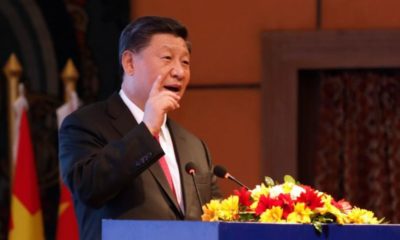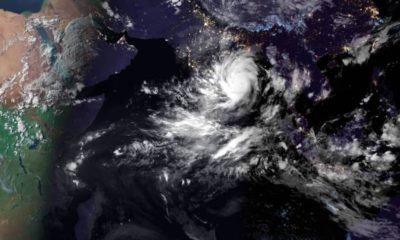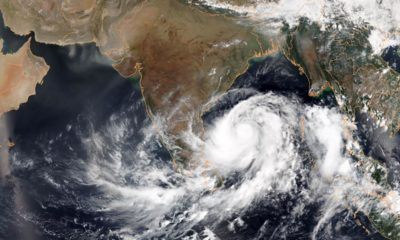World
China boat capsize: Five confirmed dead

Beijing: A passenger ship, carrying more than 450 people, capsized in China’s Yangtze River late Monday night after it was caught in a cyclonic storm, authorities said adding that barely a score of people had been rescued by Tuesday.
Of the 20 people rescued, five later succumbed in hospital, Chinese official media said adding that rescue teams attempted to enter the capsized boat from where voices and sounds have been heard.
The ship, named Dongfangzhixing, or Eastern Star, sank at around 9.30 p.m. on Monday in the Jianli — Hubei province — section of the Yangtze River, Xinhua reported, citing the river navigation administration.
A total of 20 people had been rescued by Tuesday off the passenger ship that carried 458 people — including 47 crew members, authorities said.
Chinese official media said five of the rescued passengers later died, while more than 400 continue to be reported missing as rescue teams attempted to enter the capsized boat from where voices and sounds have been heard.
The vessel — belonging to a shipping company in Chongqing — was heading to Chongqing city from Nanjing, capital of Jiangsu Province.
Among the survivors of the occupants of the boat were the captain and the chief engineer, according to the official newspaper People’s Daily.
Most people aboard the ship were tourists from eastern China aged between 50 and 80 years.
The youngest passenger was a three-year-old child, reported newspaper Oriental Vanguard newspaper.
Rescue teams, including divers and a comprehensive police team equipped with helicopters and zodiac boats continued searching for more survivors hours after the boat sank.
Chinese state media released images showing rescue workers on the keel of the sunken ship, protruding from the water surface, to determine from where the calls of possible survivors were coming.
Bad weather including fierce storm and lack of light made rescue operations difficult until Tuesday morning making these hours crucial in intensifying the search for survivors.
Chinese Prime Minister Li Keqiang reached the area to coordinate emergency tasks along with Deputy Prime Minister Ma Kai and Minister of State Yang Jing.
Chinese President Xi Jinping also gave orders to maximise rescue operations.
World
Lockdowns in China Force Urban Communities to Defy Censorship and Vent Frustration Online

Shanghai’s rich middle class is leading a wave of online dissent over the strict and prolonged lockdowns imposed in various parts of the country. Chinese internet censorship is struggling as patience is wearing thin in many urban centers, coming up with creative forms of online protests.
Social Media Posts Revealing Lockdown Tension in Shanghai
Drawn-out lockdowns are nothing new in China as authorities insist with the nation’s zero-Covid policy since the start of the pandemic. Currently over This time around, however, metropolitan areas like Shanghai are increasingly difficult to keep quiet, given that its more than 25 million residents have seen weeks of total isolation along with food shortages and many other service interruptions.
Dozens of towns and reportedly over 300 million Chinese citizens have been affected by lockdowns of different severity. As expected, urban netizens have been most outspoken over their difficulties by finding creative ways to get around state censorship and bans placed on topics, news comments and spontaneous campaigns.
Shanghai residents have been using mobile proxies and hijacking seemingly unrelated hashtags to talk about healthcare issues, delivery failures and the overall severity of their situation. The “positive energy” that the Chinese government wants to transmit during the recent prolonged series of lockdowns does not come naturally to those counting food supplies and online censors are working hard to filter words, trending topics and undesired social media sharing.
WeChat groups and message threads are under constant monitoring. Posts questioning the zero-Covid approach have been quickly deleted, including by leading Chinese health experts like Dr. Zhong Nanshan. Video footage is soon censored and protests and investigations are quickly made to disappear.
Where this has not worked, officials have exposed banners with warnings and outright threats like “watch your own mouth or face punishment”, while drones have been patrolling the city skies. Yet, if anything, this has led to further tensions and unspoken confrontation with Shanghai’s educated and affluent middle class.
Creative Online Solutions Harnessing Civic Energy
Announcements by Chinese social media that they would be publishing the IP addresses of users who “spread rumors” have not helped either. Tech industry research has shown that much of Asia’s tech-savvy population has a habit of using mobile proxies and other privacy tools, quickly finding workarounds to browse the internet freely and talk to the world about the hottest topics.
The sheer volume of forbidden posts is already a challenge for the very censorship system, experts explain. Unable to track all trending hashtags, state workers overlook topics that speak about the US, Ukraine or other popular news. Linking human rights elsewhere to their situation, Chinese online dissidents establish their informal channels and “hijack” the conversation to share personal or publicly relevant information about the Covid suppression in their town.
Sarcastic and satirical posts still dominate. Others hope to evade the censors by replacing words from famous poems or the national anthem. One thing is certain – social media, when harnessed with the right creativity, has proven its ability to mount pressure on the government in even some of the most strictly controlled tech environments like China.























